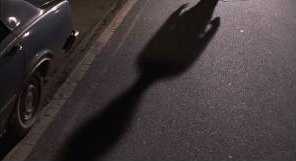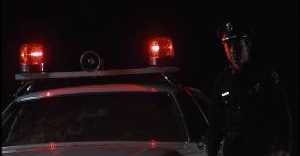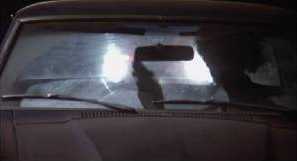The Thin Blue Line (Errol Morris, 1988)
I mean, The Thin Blue Line is very influenced by noir. It is, in its essence, a noir-like story… if you asked me, “What are the main ingredients of noir?”, I’d say that it’s not the moody lighting, it’s not the canted Dutch angles. To me it’s the feeling of inexorability, almost the form of Greek tragedy, the feeling that things inexorably move towards some disaster without the ability of anyone involved to change the outcome, to do otherwise.
Errol Morris, interviewed by Tom Ryan for Senses of Cinema
Errol Morris stumbled into the subject of his best documentary, The Thin Blue Line. In 1985 he was researching a documentary about Dr James Grigson, a psychiatrist notorious for giving testimony in court cases that led to death sentences for the accused. The research included speaking to those who had been the subject of Grigson’s testimony, and one of the prisoners he spoke to was Randall Adams, then into his seventh year of imprisonment after being sentenced to death for the 1976 shooting of police officer Robert Wood in Dallas. Adams’ death sentence had by that time been commuted, but he was still in jail and protesting his innocence. Morris started looking into the case and quickly became convinced that Adams was indeed innocent. More than that, it became very clear who had killed Robert Wood. Morris abandoned his original project and turned his efforts to building the case for Adams’ innocence. The resulting film was The Thin Blue Line, still the definitive example of an investigative documentary. The film would be important if only for its impact on that case. Yet it’s much more interesting than a simple exploration of a particular crime and its consequences; it is a triumph of execution that has been enormously influential on both documentaries and fiction films since.
The basic construction of the film is deceptively conventional, particularly looking back after its influence has been so widely absorbed. There are three basic strands that Morris weaves together. Firstly, the core of the narrative is told by the participants in interviews to camera: Adams himself; David Harris, who claimed to have been in the car as Adams shot Wood; members of the police force that investigated the case; eyewitnesses to the shooting; Adams’ lawyers; and the judge in the original trial. Secondly, Morris shows us pieces of real, documentary evidence: crime scene photos and diagrams; newspaper reports; illustrations by court reporters; mugshots and line-up photos. Finally, as each participant provides differing perspectives on the murder, we see a recreation of the events, each adding or subtracting new details based upon the account we have heard.
 Conceptually, none of this is terribly astounding in itself: we see similar things done in investigative current affairs television. Yet Morris does not confine himself to the dry presentation of an investigative journalist. His recreations, for one, are highly atmospheric, with a stark – almost stylised – staging that evoke his vision of the story as a non-fiction film noir. The effect is enhanced by the excellent score by acclaimed composer Phillip Glass, which invokes a sense of melancholy helplessness. Combined with the editing (credited to Paul Barnes, but obviously also shaped by Morris), the overall effect is almost hypnotic. Information and theories fly past with dazzling speed, but Morris outlines the results of his investigation methodically, and what unfolds is not so much a murder mystery – who killed Robert Wood is obvious fairly early in the film – but a nightmare of ever deepening proportions. Morris pulls away layer upon layer of the narrative, introducing new characters and events, and the story seems progressively more tragic as he shows just how many opportunities there were to avert not only Adams’ conviction, but also the crimes later committed by the real killer.
Conceptually, none of this is terribly astounding in itself: we see similar things done in investigative current affairs television. Yet Morris does not confine himself to the dry presentation of an investigative journalist. His recreations, for one, are highly atmospheric, with a stark – almost stylised – staging that evoke his vision of the story as a non-fiction film noir. The effect is enhanced by the excellent score by acclaimed composer Phillip Glass, which invokes a sense of melancholy helplessness. Combined with the editing (credited to Paul Barnes, but obviously also shaped by Morris), the overall effect is almost hypnotic. Information and theories fly past with dazzling speed, but Morris outlines the results of his investigation methodically, and what unfolds is not so much a murder mystery – who killed Robert Wood is obvious fairly early in the film – but a nightmare of ever deepening proportions. Morris pulls away layer upon layer of the narrative, introducing new characters and events, and the story seems progressively more tragic as he shows just how many opportunities there were to avert not only Adams’ conviction, but also the crimes later committed by the real killer.
As each character comes and goes from the tale, Morris’ famous skill as an interviewer is evident. Morris had already shown in Gates of Heaven (1980) and Vernon, Florida (1982) the remarkable insight into character he could achieve simply by letting his subjects talk, but here, in service of an investigation with enormous implications, the interviews take on a whole new dimension. Witnesses who were key to Adams’ conviction start out convincing… but keep talking and quickly reveal their foolishness. Even more revealing is the blithe assumption amongst those involved in the prosecution that they have the right man; nobody seems terribly concerned about talking about the case, or apprehensive that Morris might be onto something. Morris contrasts their genial affability with the consequences of their actions, and with the seriousness of Adams’ allegations. At one point, Adams claims that he was threatened with a gun when being intimidated into signing a confession; Morris then gives us the perspective of the seemingly friendly police officers who conducted the investigation. Whichever account you believe, the presentation of a real face completely alters our take on what Adams says. Attempts to force confessions are something we see in Hollywood films, and which we associate with villainous cops played by scary-looking actors. Here, those responsible for a terrible miscarriage of justice are shown to be non-threatening, even goofy. It only makes the whole thing scarier.
It’s also a very effective character study, even more so than Morris’ earlier films. We still meet a cast of supporting players who are every bit as eccentric and distinctive as those in his earlier films. Yet in this film Morris gives us two character portraits that are far richer and more revealing than he had provided before. There’s David Harris, who it quickly becomes clear is much more likely to have committed the murder than Adams. Harris is chilling because of what we don’t see: despite being responsible for a string of violent crimes, on-screen he’s polite, friendly and apparently helpful. (The perfect witness for the prosecution). And then there’s Randall Adams. Adams’ demeanour mixes urgency with despair: he is insistent on making his case, but you can sense his deep fatigue at having to tell the same story over and over, desperate for somebody to take note. He has become the number one expert on his own case, outlining all the flaws in the prosecution’s version of events with a rote-memorised precision that speaks of his seven long years dwelling on what went wrong.
What makes this quest for truth so interesting is the misguided criticism that has occasionally accompanied Morris’ own relationship to truth. Morris’ whole career has been to some extent a reaction to simplistic ideas about documentary, and this has led him to make films that complicate the presentation of the real world. He has claimed his work is a reaction to the cinéma vérité movement, which sought to minimise the intervention of filmmaking technique (direction, lighting, editing etc) to give a supposedly objective view of the world. Morris’ work recognises the phoniness of such a claim, and his films are notable for the artifice that he imposes on his subjects. Even his interviews tend to be stylized: this can be either by his selection of eccentric subjects and material (in his earlier films) or by more involved methods, such as his construction of elaborate “fake-real” sets for the interviews in A Brief History of Time. In The Thin Blue Line, his treatment of the interviews is restrained, and it is the use of highly cinematic reconstructions that most affronts vérité ideals.
Yet the film shows how simplistic it is to assume that staging material robs a film of its objectivity and honesty. Indeed, what is most striking about the film is its scrupulous truthfulness. Each re-enactment is driven by the account we have just heard; each version of events is visualised, as if being tried out. Even then, the view that Morris obviously favours and is seeking to convince us is true is not deceptively inflated. We never see, for example, a re-enactment that unequivocally shows us David Harris, alone at the scene, shooting Robert Wood. This does not mean, however, that all versions of the events are held up as equally arguable. It’s fashionable amongst certain academic circles to argue that there is no such thing as objective truth; that any account of events is inherently a fiction, shaped by our own prejudices, beliefs, values and so on. In re-enacting every perspective of events without distinction, Morris at first seems to be ascribing to this view. Each version is another tale, apparently equally valid. Yet Morris never loses sight of the fact that although different people might reconstruct real events in different ways, somebody pulled the trigger that night. The film builds up to one final interview, recorded on audio-tape, in which Harris inches closer and closer to a confession. It’s an unbearably tense moment, in which Morris resorts to the simplest of documentary evidence to finally settle on a truth.
Of course, the testing and weighing of different versions of the truth, to arrive at one that is true, is what Adams’ trial was supposed to do in 1977. Instead it was left to Morris to do so with his film. The Thin Blue Line was released in 1988, and Randall Adams was released from jail in 1989 after serving twelve years for a murder he did not commit. For four of those years he was facing a death penalty, which at one point came within three days of being carried out. (The film suggests the death sentence was only commuted in order to avoid the need for a retrial after the original decision was called into question). I suppose there must be people who have seen The Thin Blue Line who continue to believe in the death penalty, but it is difficult to see how.
Far from being compromised by its methods, Morris’ film is documentary filmmaking at its very best: a devastating argument about a vital issue; a document that aided in freeing a jailed man; a brilliant character study; and a dazzling exercise in technique.
Related Items
This review draws a lot on my essay Two Murders in Dallas, which looks in a lot more detail at the issue of “truth” in documentaries, and compares the film to Oliver Stone’s JFK (which is virtually a remake, except that it approaches the fiction / non-fiction divde from the other side).
For more discussion about truth, objectivity and fairness in documentary, see my reviews of Fahrenheit 9/11 and Mondovino.

